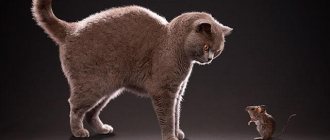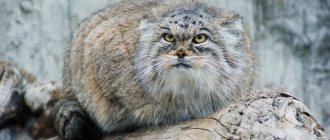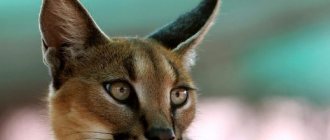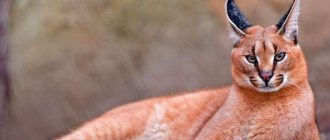There is an opinion that the steppe cat is one of the very first representatives of cats. It is believed that they existed on Earth long before the appearance of man.
They are the ancestors of modern pets. Once upon a time, cats were first domesticated in Ancient Egypt and became sacred there. Steppe cats are otherwise called “savages”. Visually, they resemble domestic cats, but they lead a wild lifestyle, which is why they differ from their counterparts.
Appearance
The wild steppe cat is a subspecies of the wild forest cat. Outwardly they are very similar, but there are also significant differences. They are more like ordinary domestic cats.
Features of the appearance of the steppe cat:
- The animals have a long and muscular body, the length of which can reach 80 centimeters. This is not to say that these are big cats;
- The weight of steppe cats does not exceed 6 kg;
- The animal's paws are strong and strong, of medium length;
- The tail is long and thin, can reach 25 centimeters in length;
- The cat's head is small in size, the muzzle is slightly elongated;
- This cat has large eyes;
- The animal has large ears, with tassels at the tips;
- The animals' fur is short but thick. In winter, the fur remains the same length, which distinguishes it from the forest cat;
- The color of steppe cats is inconspicuous, usually gray or sandy.
In a word, the steppe cat is very easy to confuse with a domestic cat.
Reproduction and care of offspring
What smells do cats not like? 5 Scents That Cats Just Hate
In winter, steppe cats play weddings. Silent animals find their voice. Nature is filled with loud sounds of fighting males. There is no particular difference from domestic relatives. The result of the rut is the pregnancy of a sexually mature female. It takes about two months (56 to 69 days) before giving birth. Most often, 2-3 kittens are born, although 5-6 are also not uncommon. Nature arranges it in such a way that kittens are born when there is a lot of food.
Important! Males show no interest in offspring. The cat is the only one raising them.
Newborn babies are absolutely defenseless. The ability to see and hear appears after a week and a half. They weigh only 35-45 g. The color is the same as that of their parents, only the patterns are clearer. The fur is sparse, not very fluffy. Kittens are kept on pure milk for the first two months. Then the mother begins to teach them to eat meat.
Steppe cat kittens
The training lasts a month. At first, the mother brings killed game, then almost dead, and at the end of training, alive. Three-month-old babies are already hunting with their mother cat. They gain independence by 6 months, more precisely after the change of milk teeth to permanent ones. They reach sexual maturity by the age of one year, but begin to reproduce only at 2 years of age.
Habitat
African wild cat is another name for the animal. This name is closely related to its habitat. Steppe cats live in the vastness of Africa and Asia.
They can also be seen in Russia, but they are found only in the Astrakhan region in semi-desert areas.
They prefer to live near bodies of water where there are thickets and where they can hide to hunt for prey. Open areas are not suitable for the steppe cat. There they can become prey for large predators. Cats also do not like to settle in areas covered with snow because they are visible there.
Features of education
Caracals easily adapt to being kept in captivity and get used to humans. But still, experienced breeders do not recommend buying an animal for families with small children.
With the right approach to education and timely suppression of bad habits, a kitten will grow into a friendly, active and affectionate cat. Education must be quite strict . But physical punishment in dealing with animals is excluded.
If you plan to keep your pet in the house, then you should remove valuables, shoes and clothes, and hide wires in advance. Owners who do not plan to breed animals should consider sterilization. After reaching sexual maturity, animals begin to actively mark their territory and can sometimes show aggression.
Lifestyle
The steppe cat is a predator just like a domestic cat. African cats have their own wild characteristics. They prefer to live along the banks of reservoirs and are not at all afraid of water, they can even swim across the river.
But snow is a problem for the African predator; they do not like to hunt on snow cover. Predators also lead a solitary cat-like lifestyle, excluding mating seasons.
Predators spend most of their time in shelters; they can occupy the burrows of foxes, porcupines and other animals, or hide in thickets of bushes.
When encountering a dangerous predator, the cat raises its tail and arches its back, its fur begins to stick out on end. If the enemy continues to attack, she lies on her back and begins to fight him off with all four paws, releasing sharp claws. At the first opportunity, he prefers to run away and hide in a shelter.
The animal's meal is usually small rodents or birds; the predator is not able to hunt larger prey than a hare.
Reproduction in natural conditions
The appearance of offspring does not depend on the time of year. But most often the female gives birth to cubs in October and February. The reasons are quite obvious. At this time there is a lot of food, therefore the period for procreation is the most suitable.
With the onset of mating season, females begin to produce a special hormone that attracts potential partners. Animals make sounds similar to coughing. This is the signal for the start of mating games. The strongest and largest male becomes the female partner. Their number can reach three in a year.
Pregnancy lasts about 3.5–4 months. Cubs (from 1 to 6) are born in a secluded place, burrow or cave. The female takes care of the offspring on her own and is forced to constantly change her shelter so that the kittens and she herself do not become prey to predators.
The cubs become completely independent after two weeks. And after six months they completely get rid of maternal care. At seven months they are capable of becoming parents themselves.
Wild cat nutrition
The African wild cat prefers to hunt animals such as small rodents, birds, and hares. The diet may also include insects and lizards. The most common rodents eaten are mice, gophers and jerboas.
Among the birds, pheasants and sparrows are distinguished, and they also prefer to hunt domestic chickens. Cats are excellent at climbing trees thanks to their long and sharp claws, climbing into bird nests and happily eating their eggs.
They can eat amphibians, and in water cartilaginous fish become food for the African cat.
Where does the manul live?
Pallas's cat lives in Central and Central Asia. The habitat of the Pallas's cat covers territories from Southern Transcaucasia and western Iran to Transbaikalia, Mongolia and Northwestern China. Depending on their territorial affiliation, Pallas' cats have slight differences in color and size. On the territory of Russia, the Pallas's cat lives in several areas: eastern, Transbaikal and Tuva-Altai. In these areas, manul is distributed in the steppe and forest-steppe zones.
In total, there are 3 subspecies of manuls: regular, Central Asian and Tibetan. The first subspecies has a typical color and this Pallas's cat lives in Mongolia and western China. The second subspecies of Pallas's cat lives in Pakistan, Kazakhstan, Uzbekistan, Afghanistan, Turkmenistan, Iran, Kyrgyzstan and Afghanistan. It is characterized by a reddish color, with clear stripes of a reddish tint. The third subspecies of Pallas's cat lives in Tibet, Nepal and Kashmir. This subspecies has gray fur with pronounced dark stripes. In winter, the color of the Tibetan Pallas's cat becomes silver.
Steppe cats in captivity
It is not difficult to meet a wild animal in a zoo. It should be noted that their life expectancy is low; they rarely live more than 6 years. In zoos, African cats live much longer.
It is believed that the steppe cat is an animal that has no place among people. However, if you start accustoming him to social life from infancy, then it is quite possible to raise an obedient cat.
Steppe cats are wild predators that live in semi-desert areas, often near bodies of water, where there are many thickets and other opportunities for shelter. They feed mainly on small rodents, birds and their eggs.
The most dangerous enemy of an animal is a wild dog. The life expectancy of a steppe cat in the wild is short - about 6 years. You can meet African cats at the zoo and even have a kitten at home.
Character and lifestyle of the steppe cat
When you hear the word “cat,” you most often imagine a fast, energetic animal, but energy and mobility are not at all characteristic of Pallas’ cat. He just can't run fast. Jumping and climbing trees is also not his taste. In addition, the cat gets tired too quickly. It is preferable for him to sleep all day and only go hunting at night.
Big company is also not to the liking of the fluffy couch potato. It is much better for him to sit comfortably in an abandoned fox or badger hole and rest until nightfall.
Since the Pallas cat does not greet his “interlocutors,” there is no one in particular to give him a voice. It is impossible to wait for songs and heartfelt screams from the steppe cat even in the most romantic periods of his life.
True, in exceptional cases he can purr in a hoarse voice, or snort with displeasure, that’s all he’s capable of. Wildcat Hunter is excellent. He has a lot of patience and endurance. The Pallas's cat can lie for a long time in the snow or among the foliage, tracking down its prey.
As prey, he chooses not too large animals - mice and birds. However, it can also cope with an animal of similar weight, for example, a hare. Of course, if the hare does not flee.
When hunting in winter, the Pallas's cat chooses places that are not too covered with snow, because his rich fur coat in the snowdrifts does him no good at all - because of it, the cat simply gets stuck in the snow.
Pallas' cat diligently avoids people; moreover, even when they are found as kittens, they are very poorly tamed, treat people with distrust and abandon their wild habits for the rest of their lives.
Even in zoos, Pallas' cats began to appear only when, with the advent of the Internet, photos of the steppe cat and great interest arose in them.
True, the cat was already popular among local residents, because its luxurious fur is true wealth. Therefore, the cat has good reason to be careful.
In the natural environment, the number of cats is reduced by owls, wolves and eagle owls. It is not easy for the Pallas's cat to escape from these predators, because he cannot always escape by running due to his slowness; all he can do is snort and bare his teeth. Cats are listed in the Red Book.
How does a manul live and what does it eat?
Pallas's cat lives in fairly harsh climatic conditions, with low temperatures and sudden changes in weather. The Pallas's cat prefers low snow cover, as its short legs do not allow it to move through deep snow. Therefore, the wild cat Pallas's cat is most numerous in areas with little snow.
Pallas's cat lives in steppes and semi-desert areas of mountains, choosing places with thickets of bushes, the presence of stone deposits and rock cracks. In the mountains, the manul cat rises to 3-4.5 km above sea level. It is rare in lowlands and forest belts.
The Pallas' cat lives sedentary and solitary, usually being active at dusk and early in the morning. During the daytime, he sleeps, hiding in a shelter. The wild manul makes its shelter under stones, in old burrows of marmots, foxes and badgers, as well as in small caves and rock crevices. The Pallas's cat is a territorial predator that jealously guards its territory and does not like guests, so it expels any unwanted visitor.
The color of the Pallas cat serves this wild cat as a kind of camouflage, which helps him in hunting and allows him to remain unnoticed by prey. However, the manul cat is one of the most clumsy and slow representatives of the cat family. But excellent eyesight and hearing allow him to be a skilled catcher.
Pallas's cat feeds on various mouse-like rodents and pikas. Occasionally, Pallas's cat feeds on hares, birds, gophers and marmots. Manul catches its prey by cunning. He waits for her at the hole or watches for the victim, hiding near the stones, after which he attacks, making a sharp lunge. This wild cat is very careful when hunting. Pallas's cat is not able to run fast, so chasing prey is not his strong point. In summer, the Pallas's cat feeds on various large insects, in case of a shortage of rodents.
Despite its harsh appearance, the Pallas's cat is not aggressive. Pallas's cat has practically no enemies; only wolves and large birds of prey pose a danger to this wild cat. The animal Pallas' cat is not one of those who is in a hurry to start a showdown and repel the enemy. This cat is trying to flee and lie down in a shelter. But when the Pallas cat is caught by surprise and there is no escape route to the shelter, then he begins to snort menacingly and bares his sharp teeth.











